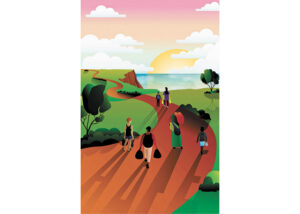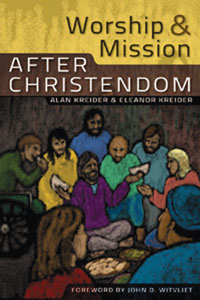Chris Koelle: Religious Art Reborn
Web: http://chriskoelle.com/ & http://silveragency.net/
Bio
Chris Koelle is an artist and illustrator living in Greenville, South Carolina with his wife Annie and son Marshall. The majority of his work, as it can be found online, has a distinctly religious bent. His tendency to deal with Biblical themes, however, should not lead the reader to make assumptions about his work. One need glance through the following survey of his work to see that Chris Koelle brings a visceral sensibility to his artistic creations, from his illustrations of the book of Job and the book of Revelation, to his occasional work with graphic novelists and cyclists. Many viewers will be most familiar with his work from the art collection Postmodern Bible Stories which collects iconoclastic and theologically challenging artwork that depict the events of Biblical narratives. It is in this spirit that much of Chris Koelle’s work is done, pointing to his own biography as an unorthodoxly religious person for whom religious art is not a dead genre, but a medium ready for resurrection.
Overview
As was mentioned, the following brings together the religious art of Chris Koelle as a sort of survey. The thematic undertone is that of iconoclastic religious art and its rebirth in Koelle’s work. In addition to the works themselves I will give brief philosophical and theological commentaries on each piece in a way that hopefully conforms to the spirit in which the work was done. The icons of the past, particularly religious icons printed on cards or formed in stained glass, no longer hold sway tin contemporary religious discourse. Religious art has tended towards the clichéd and airbrushed white Jesus, or overproduced and sanitized pictures of sunsets and sunrises. The violence and intensity of religious discourse has not been represented, but rather repressed. Here I refer to violence and intensity in a positive light, for the most part. When I say violence I don’t mean destruction or acts done with malicious intent. Instead I mean violence as a sort of wrenching or crossing of old dogmatic boundaries. There is a sense that Christianity itself is being reborn in a form unfamiliar to both the sacred and secular public, and it makes sense that religious art would undergo a shift as well. Chris Koelle’s work, I think, is a part of the postmodern, postreligious, postsecular trend in the West—a trend worth exploring in the context of particular pieces of art and illustrations of what many still see to be a challenging Biblical narrative…
> http://drawn.ca/wordpress/wp-content/images/portland.jpg
The Face and The Gaze
This sketch of three faces, although not specifically a religious piece, is significant because it draws attention to the gaze. Philosophically speaking the gaze is what allows us to apprehend things, and people, and ideas that exist outside of the self. The gaze mediates our relationship with the visual world. The German philosopher G.W.F. Hegel writes of the importance of recognition in his magnum opus The Phenomenology of Spirit. He writes with conviction that identity depends upon mutual recognition: I see you seeing me, or something to that effect. The gaze presented in “Ready or Not” implies some sort of recognition beyond mundane everyday interactions, and in doing so comments upon the purpose of religious art—that is, to open up our gaze to apprehend the divine.
Ready or Not, August 2010 Sketch
> http://dribbble.com/shots/50136-Ready-or-Not
Fire and the Book
“Exult and Hope” being a part of the same project as the previous work (a 50 page illustrated revision of Biblical texts), is decidedly different. Here Koelle points past the gaze to the rapture of revelation—an experience that is often treated reductively in a society that praises what it can prove with reason. St. Augustine held that humans require both reason and revelation, and the presence of the book in “Exult in Hope” shows the viewer that there is indeed a tension between spirit (symbolized by the dove) and word (symbolized by the book which may or may not be a Bible).
Exult in Hope, September 2010
> http://dribbble.com/shots/50136-Ready-or-Not
Angst and Agony
The strength of Koelle’s work is that he never shies away from the angst and agony of life. Theologians call this “theodicy” – the idea that pain and suffering are a test initiated by God. This view has lost a lot of traction given the discrepancy between a loving God and a punishing universe. Koelle’s work dives into this contradiction, particularly his depictions of the Book of Job which we will see later in our survey. This particular piece depicts the fifth chapter of the Book of Revelation where the writer states: “I wept and wept because no one was found who was worthy to open the scroll or look inside.”
Revelation Ch. 5, August 2011
> http://dribbble.com/shots/228375-RevelationApp-Chapter-5
Rapture
Later, as he illustrates the seventh chapter of the Book of Revelation, Koelle depicts the final line of the chapter: “he will lead them to springs of living water. And God will wipe away every tear from their eyes.” This rapturous event is depicted in such a way that will challenge the most cynical and sceptical viewer with its authenticity; and at the same time the piece is also challenging to the staunch believer with its carnal and visceral style.
Revelation Ch. 7, August 2011
> http://dribbble.com/shots/236003-RevelationApp-Chapter-7
The Crux of Finitude
The crux of the debate between secularism and the religious is not so much the gap between finitude and infinitude, but the ability of humans or divinities to cross that gap. Koelle continues his illustration of the book of Revelation with this striking illustration of the human being before the divine. “Kenosis” is the term for God’s self-emptying and incarnation, and some philosophers take this self-reduction to be a one-way street. God becoming human means that objective truth and meaning are no longer in place, and many don’t see this as such a bad thing.
Revelation Ch. 10, August 2011
> http://dribbble.com/shots/265982-RevelationApp-Chapter-10
Violence
Koelle’s illustrations are challenging to the Christian industrial complex in many ways. Here we see his lack of hesitation in depicting violent scenes (here for a graphic novel). Jarring as it may be for many viewers (see also the pictures on the front cover of this survey), Koelle’s work in this vein serves the viewer a healthy dose of realism, and may awaken religious and secular viewers alike to the violence present in our society (both symbolic and literal).
Images from Battle Surgeon 150 p. Illustrated Graphic Novel
> http://behance.vo.llnwd.net/profiles17/440293/projects/2331382/5b5b65284cd37fbbd9c2c6a2a61f7bb4.jpg
Bodies, Embodiment, Incarnation
Further challenging the emphasis placed upon transcendence and spirituality in contemporary Christian discourse, Koelle’s images from the book Inciting Incidents place emphasis on the body and the flesh—particularly evident in the tendrils escaping from the ribs of the illustrated woman.
Images from Inciting Incidents Moody Publishers (September 2012) Accompanying an essay by Mandy Thompson
> http://25.media.tumblr.com/tumblr_m6cadlmfdA1qzwb0mo1_1280.jpg > http://chriskoelle.com/files/gimgs/30_chriskoelle-incitingincidents-ch2.jpg
Embrace
This etching, also from the collection Postmodern Bible Stories, is a fairly abstract but not entirely unrepresentational depiction of the story of the prodigal son. Having taken his inheritance and gone, and then returned having squandered it only to receive a royal welcome, the story illustrates grace—a forgiveness without bounds. Koelle’s work seems to do the same, with the son being almost entirely encompassed by the embrace of the father—a religious image to be sure.
The Prodigal Son Etching and Aquatint, (Edition of 25) Also from Postmodern Bible Stories, Relevant Books, 2006
> http://behance.vo.llnwd.net/profiles17/440293/projects/2331382/121555edb635fe5fe27fd0c002f4a18a.jpg
Horror and Abyss
Returning to angst and anxiety, as Koelle frequently does in his work, “Job Passes the Test” seems to encompass all of the horror and abyss of a life in which all support is withdrawn. In a troublesome way the title implies that the Book of Job depicts God testing humanity, rather than what might be a more comfortable existential explanation (humans cannot count on consistency from God, and cannot hold God accountable for circumstance). Koelle’s work, apart from the title, seems to capture perfectly the emptiness of isolated life—a reality dealt with quite differently by secular and religious institutions.
Job Passes The Test, from Postmodern Bible Stories, Relevant Books, 2006
> http://www.flickr.com/photos/flyinskwrl88/3461175463/
Between Irony and Authenticity
Lastly, and to end on a lighter note, Koelle has done work with vintage cycling. What is fascinating about this work, concerning the religious and the secular worlds alike, is that his work is situated between authenticity and irony. The ironic potential of “Sweet Ride” is not entirely actualized, and yet it is present. Koelle could have accentuated the work for the sake of humour but instead he chose to retain tasteful proportions and a measure of authenticity. This seems to be reflective of Koelle himself as well as his work as a whole.
Sweet Ride, 5"x7" Black and White > http://img3.etsystatic.com/000/0/5634626/il_570xN.192447179.jpg
Important Note: The links to these images are subject to change and the titles for works that I have used are not necessarily or consistently the official titles. Also, if Chris Koelle is out there watching and thinks I have misrepresented him I am available via email (available on my other blog in my CV).






